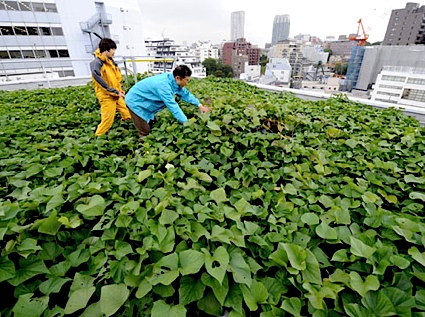In 2006, the Canadian Government established a policy supporting the implementation of a green roof strategy. This strategy stated that, where feasible, green roofs will cover 50% to 75% of newly constructed and City-owned buildings. For existing buildings owned by the City, green roofs have to be considered where existing roof systems are being replaced. The Canadian Government also identified financial incentives to support the implementation of green roofs through funding support from the water management and environmental (air quality) agencies. To further support the green roof strategy, a series of technical booklets and workshops have been developed to raise awareness on the new green roof strategy among developers and stakeholders.
Now, there are approximately 135 built green roofs in Toronto, covering more than 36,517 m2 (119, 775 ft2). They include green roofs on publicly- and privately-owned buildings.

Toronto Rekai Centre (Toronto green roofs website)
The US Government has also pro-actively encouraged the use of green roofs through the development and implementation of new policies. In Portland, the local government has introduced targets for new buildings which encourage the use of green roofs. This has resulted in approximately four acres of green roofs being constructed in Portland. These targets include;
- All new City-owned buildings are required to be built with a green roof that covers at least 70% of the roof
- The City Zoning Code offers developers floor area bonuses when they implement stipulated options, like a green roof
- A reduction in stormwater management charge for buildings which have a green roof
In 2003, The Chicago Department of Planning and Development begin actively encouraging green roofs through their "green roof policy matrix": any project that receives public financial assistance or is in a Planned Development or Lakefront Protection Ordinance Development has to contain certain design elements, including a green roof. In 2005, the Chicago Department of Environment began awarding $5000 grants to residential and small commercial building (less than 10,000 sq. ft.) owners who installed a green roof. Since 2005, 72 green roof grants have been awarded (ref: Area Chicago).

Chicago City Hall (Land8)
Chicago classes itself as America's leading light in green roofs and has developed it's own website with advice, support and good examples.
In Tokyo, a growing number of people in the famously crowded metropolis are becoming city farmers, planting crops atop tall buildings or deep underground, in an attempt to tackle the cities problems with food safety, climate warming and unemployment. Since 2008, encouraged by environment-conscious Tokyo governor Shintaro Ishihara, a number of building owners in the capital have introduced roof- top gardening as a way to prevent overheating.
A good example of this is the "Green Potato" project, launched by two subsidiaries of Japanese telecommunications giant NTT Corp., where new city farmers grow sweet potatos on the roof of the companies offices. Many of these "farmers" are new to the work, being unemployed city workers who lost their jobs during the economic crisis. Now, they have work, help cool down Tokyo and also harvest sweet potatoes in autumn.
Sweet potatoes are are particularly good for roof- tops because their wide leaves can cover the whole surface and are efficient at evapotranspiration which has a cooling effecton the air temperatuer. The temperature of a roof area not covered by potato leaves was as much as 27 degrees Celsius hotter than an area covered by the leaves, according to a survey taken on top of the NTT Facilities building.

Green Potato project (City Farmer)


